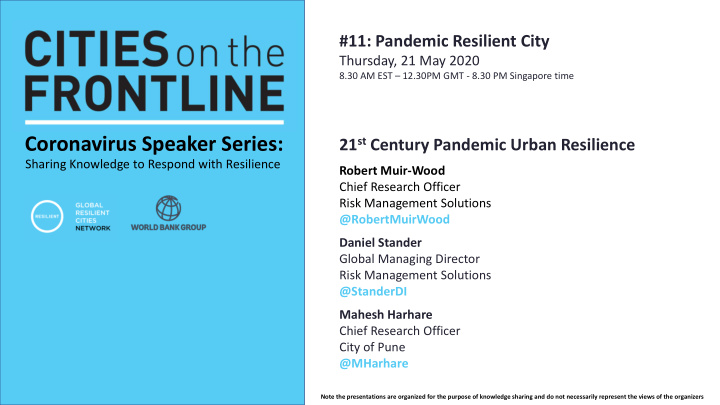



#11: Pandemic Resilient City Thursday, 21 May 2020 8.30 AM EST – 12.30PM GMT - 8.30 PM Singapore time 21 st Century Pandemic Urban Resilience Coronavirus Speaker Series: Sharing Knowledge to Respond with Resilience Robert Muir-Wood Chief Research Officer Risk Management Solutions @RobertMuirWood Daniel Stander Global Managing Director Risk Management Solutions @StanderDI Mahesh Harhare Chief Research Officer City of Pune @MHarhare Note the presentations are organized for the purpose of knowledge sharing and do not necessarily represent the views of the organizers
Transmissibility ▪ R 0 = Basic Reproduction Number ▪ R 0 = Expected number of secondary cases that each case causes ▪ Interdependence: disease + human environment ▪ COVID-19? ▪ Initially… R 1.5 – 3.5 t = 2 t = 1 Susceptible Infective Recovered t = 2
Transmissibility wit ith Social Dis istancing ▪ R 0 = Basic Reproduction Number ▪ R 0 = Expected number of secondary cases that each case causes ▪ Interdependence: disease + human environment ▪ COVID-19? ▪ Initially… R 1.5 – 3.5 t = 2 t = 2 Distancing… R 0.3 – 0.5 ▪ t = 1 Susceptible Infective Recovered t = 2 t = 2
From Human Contact to Transmission (Distance x Duration x Infectiousness) 5m Illustrative 4m Low 1% Risk 3m Separation Distance Moderate 2m 5% Risk 1m High 25% Risk 0m 0sec 1min 1hr Contact Duration
Measuring Human Contact (hrs per day per person in ‘close contact’) Office Production Transport Match Elevator Commute Bar Restaurant
Measuring Human Contact (Prolonged vs. Multiple) ▪ Auditing contact using ‘huddle’ metric… ▪ Hours per day within 2m ▪ Number of different people per huddle 1% 10% Cohabiting Driving a Bus 8 hrs <2m x 1 contact x 1% infectious 4 hrs <2m x 100 contacts x 1% infectious = 1% risk of transmission = 10% risk of transmission
Measuring Human Contact (Maximizing Social Distancing and Economic Productivity) Measure Remeasure Apply • Huddle (hrs / person / day) • Huddle (hrs / person / day) Social • Transmission • Transmission Distancing • Productivity • Productivity
Higher Schools Neutral Lower Closed Schools Re-Open Schools School Buses Private Transport Classroom Distancing More Classes Longer School Hours
CRO Focus Questions Next Three Months 1 Role? How do you negotiate your role vs. that of national public health? 2 Data? What data do you need to perform your role? 3 Pandemic Plus…? How do you balance managing risks of infectious disease with potential impacts from other shocks / stresses? 4 Particularities? What are the particular challenges of your city which make managing pandemics unique?
Partial Herd Immunity ▪ R t = Basic Reproduction Number” at time t ▪ R t = Expected number of secondary cases that each case causes in population with partial herd immunity ▪ COVID-19? ▪ Initially… R t 1.5 – 3.5 t = 2 ▪ Partial herd… R t 1.0 – 1.5 t = 1 Susceptible Infective Recovered t = 2
South Korea Harnessing Recent Experience Improved Risk Management 1 Transparency and Openness 2 Containment and Mitigation 3 Triage and Treatment System 4 Massive Screening and Fast-Tracking
Future Pandemic Risk Management Beyond WHO Transmission R t International ‘fire - fighting’ Measurement of human capability for novel viruses contact + transmissibility Physical Resilience Risk Transfer Architectural + technological Parametric insurance for resilience measures business survival
CRO Focus Questions Next Three Years 1 Define Targets? Can you define – in quantitative terms – what pandemic resilience means for your city? 2 Avoid Amnesia? How do you ensure the memory of COVID19 is preserved? 3 Institutionalize Lessons? What are the most important take-aways? 4 Drive Legacy? How can you effectively campaign for legacy actions?
A Pandemic Cheat Sheet for CROs Robert.Muir-Wood@rms.com @RobertMuirWood and Daniel.Stander@rms.com @StanderDI
Coronavirus Speaker Series: Sharing Knowledge to Respond with Resilience
Recommend
More recommend